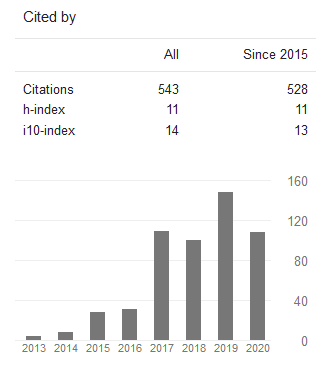Segmentasi Citra Sapi Berbasis Deteksi Tepi Menggunakan Algoritma Canny Edge Detection
DOI:
https://doi.org/10.24002/jbi.v8i1.1074Abstract
Abstract.
The determination of the cattle price is generally agreed through bargaining, it is not based on the weight of the cows being sold. Most people mainly use rough calculation. There are formulas to calculate the weight but they require perimeter information of chest size and body length. It is necessary to measure the cow manually, but in reality it is not easy to do because the cow is difficult to control. Therefore, it requires a tool that can help measure easily. This article represents the early stages of research to determine the weight of cows from the cow image acquisition. It focuses on segmentation and image processing. The image acquisition results are processed using five scenarios. The results of the evaluation show that scenario 3 (Median Blur and Canny) has the best result with the value of 230,051 MSE and 24,524 dB PSNR.
Keywords: Edge Detection, Canny, Segmentation, Cow, Image Processing
Abstrak.
Penentuan harga sapi umumnya disepakati melalui tawar menawar bukan didasarkan pada bobot sapi yang dijual. Kebanyakan menggunakan perhitungan secara kasar maupun secara kira-kira. Terdapat rumus untuk menghitung bobot sapi, rumus yang ada memerlukan informasi terkait lingkar dada dan panjang badan. Untuk mendapatkan nilai lingkar dada dan panjang badan perlu dilakukan pengukuran secara manual, namun di lapangan hal tersebut tidak mudah dilakukan karena sapi sulit dikondisikan. Oleh karena itu diperlukan alat yang dapat mengukur secara mudah. Tulisan ini merupakan tahap awal dari penelitian untuk menentukan bobot sapi dari hasil akuisisi citra sapi. Oleh sebab itu pada tahap awal ini difokuskan pada segmentasi serta pengolahan citra sapi untuk menentukan deteksi tepi terbaik yang nantinya digunakan pada penelitian selanjutnya. Citra sapi hasil akuisisi diproses menggunakan lima buah skenario deteksi tepi. Hasil evaluasi menujukkan bahwa Skenario 3 (Median Blur dan Canny) memiliki hasil yang terbaik dengan nilai MSE sebesar 230.051 dan PSNR sebesar 24.524 dB.
Kata Kunci: Deteksi Tepi, Canny, Segmentasi, Sapi, Pengolahan Citra Digital.
References
Abidin, Z. (2008). Penggemukan Sapi Potong. Jakarta: AgroMedia Pustaka.
Ahmad, U. (2005). Pengolahan Citra Digital & Teknik Pemgrogramannya (1st ed.). Yogyakarta: Graha Ilmu.
Arbeláez, P., Maire, M., Fowlkes, C., & Malik, J. (2011). Contour detection and hierarchical image segmentation. IEEE Transactions on Pattern Analysis and Machine Intelligence, 33(5), 898–916. doi:10.1109/tpami.2010.161
Bassil, Y. (2012). Image Steganography based on a Parameterized canny edge detection algorithm. International Journal of Computer Applications, 60(4), 35–40.
Dollar, P., & Zitnick, C. L. (2015). Fast edge detection using structured forests. IEEE Transactions on Pattern Analysis and Machine Intelligence, 37(8), 1558–1570. doi:10.1109/tpami.2014.2377715
Ferrari, V., Fevrier, L., Jurie, F., & Schmid, C. (2008). Groups of adjacent contour segments for object detection. IEEE Transactions on Pattern Analysis and Machine Intelligence, 30(1), 36–51. doi:10.1109/tpami.2007.1144
Gonzalez, R. C., & Woods, R. E. (2007). Digital image processing (3rd ed.). United States: Prentice Hall.
Juneja, M., & Sandhu, P. S. (2009). Performance Evaluation of Edge Detection Techniques for Images in Spatial Domain. International Journal of Computer Theory and Engineering, 1(5), 614. doi:http://dx.doi.org/10.7763/IJCTE.2009.V1.100
Kementan - BPS. (2011). Rilis Hasil Akhir PSPK2011. Kementerian Pertanian - Badan Pusat Statistik
Lasfeto, D. B., Susanto, A., & Agus, A. (2012). Aplikasi Pengolahan Citra untuk Estimasi Bobot Badan Ternak Sapi. Buletin Peternakan, 32(3), 167–176. doi:10.21059/buletinpeternak.v32i3.1254
Maini, R., & Aggarwal, H. (2009). Study and Comparison of Various Image Edge Detection Techniques. International Journal of Image Processing (IJIP), 3(1), 1–11.
Melin, P., Gonzalez, C. I., Castro, J. R., Mendoza, O., & Castillo, O. (2014). Edge-detection method for image processing based on generalized type-2 fuzzy logic. IEEE Transactions on Fuzzy Systems, 22(6), 1515–1525. doi:10.1109/tfuzz.2013.2297159
Muthukrishnan, R., & Radha, M. (2011). Edge detection techniques for image segmentation. International Journal of Computer Science and Information Technology, 3(6), 259–267. doi:10.5121/ijcsit.2011.3620
Negi, V., & Mishra, K. P. (2016). An algorithm for blurred thermal image edge enhancement for security by image processing technique. International Research Journal of Engineering and Technology Certified Journal, 03(08), 1593–1597.
Paputungan, U., Hakim, L., Ciptadi, G., & Lapian, H. F. N. (2013). The Estimation Accuracy of Live Weight from Metric Body Measurements in Ongole Grade Cows. Journal of the Indonesian Tropical Animal Agriculture, 38(3), . doi:10.14710/jitaa.38.3.149-155
Poobathy, D., & Chezian, R. M. (2014). Edge detection operators: Peak signal to noise ratio based comparison. International Journal of Image, Graphics and Signal Processing, 6(10), 55–61. doi:10.5815/ijigsp.2014.10.07
Ramamurthy, B., & Chandran, K. R. (2011). Content based Image Retrieval for Medical Images using Canny Edge Detection Algorithm. International Journal of Computer Applications, 17(6), 32–37. doi:10.5120/2222-2831
Saini, V., & Garg, R. (2013). Performance Enhancement of Edge Detector for High Definition and Blurred Images. International Journal on Intelligent Electronic Systems, 7(1), 33–36. doi:10.18000/ijies.30123
Sangeetha, D., & Deepa, P. (2016). FPGA implementation of cost-effective robust Canny edge detection algorithm. . doi:10.1007/s11554-016-0582-2
Wu, J., Yin, Z., & Xiong, Y. (2007). The fast multilevel fuzzy edge detection of blurry images. IEEE Signal Processing Letters, 14(5), 344–347. doi:10.1109/lsp.2006.888087
Xu, Q., Varadarajan, S., Chakrabarti, C., & Karam, L. J. (2014). A distributed canny edge detector: Algorithm and FPGA implementation. IEEE Transactions on Image Processing, 23(7), 2944–2960. doi:10.1109/tip.2014.2311656
Downloads
Published
Issue
Section
License
Copyright of this journal is assigned to Jurnal Buana Informatika as the journal publisher by the knowledge of author, whilst the moral right of the publication belongs to author. Every printed and electronic publications are open access for educational purposes, research, and library. The editorial board is not responsible for copyright violation to the other than them aims mentioned before. The reproduction of any part of this journal (printed or online) will be allowed only with a written permission from Jurnal Buana Informatika.
This work is licensed under a Creative Commons Attribution-ShareAlike 4.0 International License.









